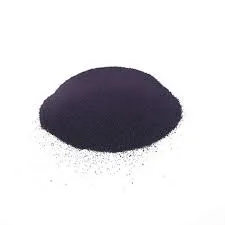Exploring the Sustainable Benefits of Plant-Based Indigo Dye in Textile Production and Fashion Industry
Exploring the World of Plant Indigo Dye Products A Journey Through Culture and Craftsmanship
In the realm of natural dyes, the vibrant hues extracted from the indigo plant stand out with a magnificent legacy that spans thousands of years. Famous for its deep blue shades, indigo dye has played a crucial role in various cultures, influencing fashion, art, and even the economy. Today, the resurgence of sustainable practices has sparked renewed interest in plant-based indigo dye products, making them a focal point for artisans and environmentally-conscious consumers alike.
Indigo dye is derived from several plant species, the most notable being Indigofera tinctoria. The process of extracting dye from this plant involves fermenting the leaves to release the indigo pigment, which is then precipitated and dried into a powder form. This ancient technique, refined over generations, can be traced back to regions such as India, Japan, and Africa, where indigo was not only used as a textile colorant but also held cultural significance.
Historically, indigo was a luxury item, often referred to as blue gold. In places like Gujarat, India, the cultivation of indigo became a vital economic activity, contributing to trade networks and local livelihoods. The unique chemistry of indigo allows it to bond with fibers, producing a color that becomes even more vibrant with age and washing. This quality made it highly sought after among dyers and textile manufacturers, leading to its adoption in different forms across various cultures.
Today, the revival of interest in plant indigo dye products can be linked to the global shift towards sustainability and the rejection of synthetic dyes, which often contain harmful chemicals. Consumers are increasingly aware of the environmental impact of their purchases and are seeking out alternatives that align with eco-friendly practices. Plant indigo dye products, being natural, non-toxic, and biodegradable, fit this growing demand perfectly.
plant indigo dye product

Artisans from around the globe are rediscovering indigo dyeing techniques, benefiting from both traditional practices and modern innovations. From hand-dyed textiles to handcrafted clothing, the range of indigo products available today is vast. Items like scarves, dresses, bags, and home décor, showcasing intricate patterns and shades, are all crafted using traditional resist-dyeing methods that highlight the beauty of this natural pigment.
Moreover, the aesthetic appeal of indigo is undeniable. Its unique ability to create various shades—from soft sky blue to deep navy—makes it a versatile choice in fashion and design. The subtle variations that occur during the dyeing process are celebrated by artisans, adding a layer of uniqueness to each product. Wearing or using indigo-dyed items, therefore, not only supports sustainable practices but also connects consumers to a rich cultural heritage.
As we navigate through an increasingly industrialized world, it is refreshing to see the revival of traditional crafts like indigo dyeing. The integration of indigo dye products into contemporary life serves as a reminder of the beauty that nature can provide and the importance of preserving artisanal skills. It encourages a sense of mindfulness regarding what we wear and how it is made, promoting a deeper appreciation for craftsmanship and ethical consumption.
In conclusion, plant indigo dye products encapsulate a rich tradition that bridges history, culture, and craft. As more consumers turn to sustainable and ethically produced items, the future looks promising for these timeless treasures. By choosing indigo products, one is not just making a fashion statement; one is also becoming part of an ongoing narrative that values heritage, sustainability, and creativity.
-
The Timeless Art of Denim Indigo Dye
NewsJul.01,2025
-
The Rise of Sulfur Dyed Denim
NewsJul.01,2025
-
The Rich Revival of the Best Indigo Dye
NewsJul.01,2025
-
The Enduring Strength of Sulphur Black
NewsJul.01,2025
-
The Ancient Art of Chinese Indigo Dye
NewsJul.01,2025
-
Industry Power of Indigo
NewsJul.01,2025
-
Black Sulfur is Leading the Next Wave
NewsJul.01,2025

Sulphur Black
1.Name: sulphur black; Sulfur Black; Sulphur Black 1;
2.Structure formula:
3.Molecule formula: C6H4N2O5
4.CAS No.: 1326-82-5
5.HS code: 32041911
6.Product specification:Appearance:black phosphorus flakes; black liquid

Bromo Indigo; Vat Bromo-Indigo; C.I.Vat Blue 5
1.Name: Bromo indigo; Vat bromo-indigo; C.I.Vat blue 5;
2.Structure formula:
3.Molecule formula: C16H6Br4N2O2
4.CAS No.: 2475-31-2
5.HS code: 3204151000 6.Major usage and instruction: Be mainly used to dye cotton fabrics.

Indigo Blue Vat Blue
1.Name: indigo blue,vat blue 1,
2.Structure formula:
3.Molecule formula: C16H10N2O2
4.. CAS No.: 482-89-3
5.Molecule weight: 262.62
6.HS code: 3204151000
7.Major usage and instruction: Be mainly used to dye cotton fabrics.

